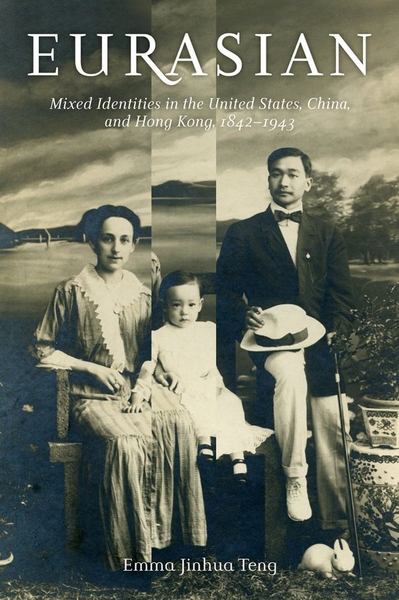In 2001, a Time magazine story heralded a “Eurasian Invasion” in the United States, symbolized by multiethnic celebrities such as golfer Tiger Woods and model Li Jiaxin. People of mixed Asian and Western descent, the piece stated, had become “the poster children of globalization” at the turn of the millennium.
Perhaps, although as MIT historian Emma Teng chronicles in a new book, relationships and marriages between Westerners and Asians constitute a far older and richer phenomenon than is usually recognized. The issue of Eurasian identity was already a matter of discussion among public intellectuals in the 19th century, and became more common by the first decades of the 20th century.
Consider the case of Mae Watkins, an American who in the early 1900s met Tiam Hock Franking, a Chinese youth, at Ann Arbor High School in Michigan. As students at the University of Michigan they married, and in so doing, stepped into a legal minefield. While intermarriage between whites and Chinese was allowed in Michigan at the time, a 1907 U.S. law removed American citizenship from women who married foreign nationals. So the couple moved to China in 1914, although technically, China prohibited marriages between Chinese students abroad and foreign women.
The couple’s oldest child, a son born in the United States, had American citizenship. But their two younger children, born in China, could not gain American citizenship until the 1940s. And Mae Watkins Franking, for her part, accepted her new national and ethnic identity, which she described in a ghostwritten memoir published in the 1920s.
“She did fully embrace her Chinese identity,” says Teng, the T.T. and Wei Fong Chao Associate Professor of Asian Civilizations. “She considered herself to be Chinese.”
For the Frankings and many other mixed families, identity is a complicated matter played out in evolving legal, cultural and political arenas. As Teng writes in her book — “Eurasian: Mixed Identities in the United States, China, and Hong Kong, 1842-1943,” published this month by the University of California Press — that has been the case for more than 150 years.
‘Of good to both sides’
Views on multiracial people differ from country to country. Americans have often tended to label people as non-Caucasian if either parent is from another ethnicity, but in China, children were traditionally assigned the same ethnic identity as their fathers. As Teng recounts in the book, these definitions shaped lives and led to unusual circumstances for many people. The prominent Hong Kong businessman and philanthropist Robert Ho Tung, for one, was born in 1862 to a Dutch father and Chinese mother, then became a dual Chinese and British subject; choosing to affiliate himself with the Chinese, he used a Chinese surname, and strictly upheld Chinese traditions within his family.
By then, the subject of multiethnic mixing was actually the subject of some public debate, as Teng details. Soon after the acceleration of China’s interaction with the outside world in the 1840s, a series of Chinese intellectuals — including Kang Youwei, Wu Tingfang, Pan Guangdan and Tang Caichang — started making the case in favor of mixed Euro-Asian lineages, which would be “productive of good to both sides,” in Wu Tingfang’s words.
Such views were rarer in the United States and Europe, although Teng did locate a handful of English-language scholars and missionaries who advocated Eurasian mixing at roughly the same time — as well as texts such as Franking’s, which are based on firsthand experience.
Indeed, Teng’s book synthesizes research from memoirs and a wide variety of archival materials to reconstruct the Eurasian experience in Shanghai, Hong Kong, California, New York and other places.
As Teng acknowledges, her work is not intended to be a comprehensive history; among other things, the archival record contains proportionately more evidence about the well-off and literate than it does about, say, uneducated and more transient workers.
“Most of the working-class people didn’t leave written records,” Teng acknowledges. That would include the thousands of Chinese workers who came to the United States in the 1860s to complete the first transcontinental railroad, for instance. Yet Teng had the good fortune to meet one source whose great-grandfather, one of the early “railroad Chinese,” married an Irish-American woman during his time in San Francisco.
Students and teaching driving research
To a significant extent, Teng says, the genesis of the project came from her experiences with students at MIT, where she has taught since 1995. This is her second book; her first, on Chinese colonial travel writing, was published in 2004.
Scholars have responded positively to “Eurasian.” Evelyn Hu-DeHart, a historian at Brown University, calls it a “truly transnational and multicultural intellectual project” that draws on English and Chinese sources “with facility and depth,” while Kornel Chang, a historian at Rutgers University at Newark, calls it “beautifully written and thoughtfully crafted.”
For her part, Teng says she hopes the book will help people think critically about the assumptions we still make today when discussing ethnicity and identity. As she puts it, “I don’t think we’ve moved away as much as we should from biology” as a way of categorizing people. Even “the very discussion of mixed races” as a common feature of today’s world, Teng says, still implies that ethnic populations were simply homogenous 50 or 100 years ago. As her book reminds us, history says otherwise.
MIT historian’s new book studies cross-cultural Asian-American families since the 19th century.
Publication Date:

Caption:
Mae Watkins Franking and her children Credits:
Photo courtesy of William and Christopher Franking

Credits:
Image: University of California Press





